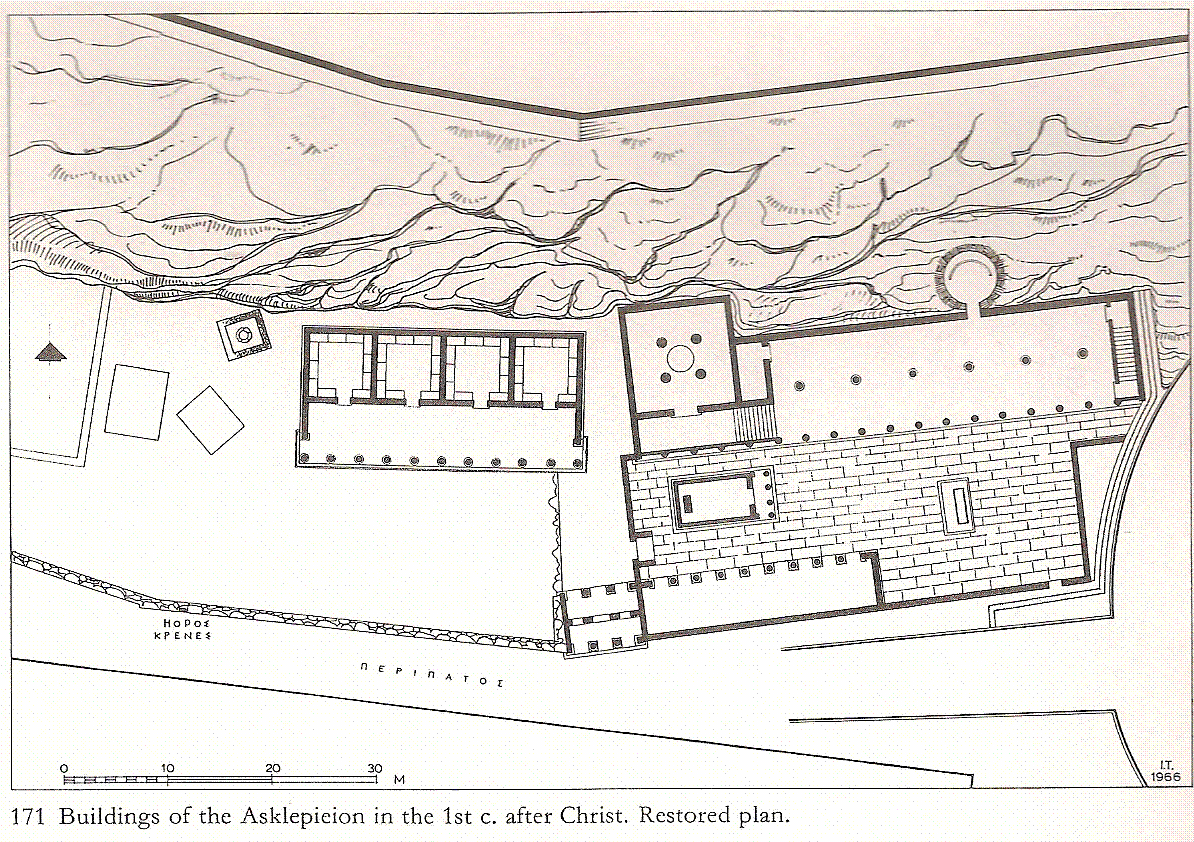Shrines on the Slopes of the Acropolis
There are a great many sites based around the slopes of the Acropolis. In the interests of retaining my sanity I give brief details on all the cults I can find sufficient, reliable sources for before focusing on the three sites with the most literature; the Asklepieion, the shrine of Pan (and the Nymphs) and the shrine of Apollo Hypo Makrais.
Archaeological Development
The site is located around the slopes of the Acropolis, development is on both the North and Eastern sides of the Acropolis (see site plan for division between the two). There are a great many different shrines, most of which are linked to 'popular' rustic religion rather than the grander, more established cults on top of the Acropolis.
The exception to this rule is found on the South Slope, where the Athenian Asklepieion was located. This small complex was home to a spring house, which far outdates the rest of the complex, and a pair of Stoas, one Ionic and one Doric. As such it is far more developed than the other sites on the Acropolis' slopes.
Gods/Heroes
North Slope
- Pan and the Nymphs (worshipped in a shallow cave with indents cut in the rock for votive offerings)[1] His worship in Athens is probably linked to the myth, espoused in Herodotus, that he appeared to Pheidippides and asked why the Athenians did not worship him despite the help he had given them. Arguably he was also creditted with the 'panic' amongst the Persians which allowed Athens to defeat them at Marathon. [2]
- Apollo Hypo Makrais (or Hypoakraios or Hyp'Akrais) Evidence only found in the Roman period, literally 'Apollo below the heights', located in a similar cave to Pan's sanctuary[3]. It is also possible that this Apollo was worshipped as Pythios, this is suggested by Euripides' Ion 283-285[4]
- Aphrodite (and possibly Eros) had an open air sanctuary in the same area, believed to have been worshipped in a walled area set against the rock face.[5]
East Slope
- Aglauros. Type of sanctuary unknown as the only evidence found is a stele in the location dedicated to a priestess of Aglauros. We know that the Ephebic Oath was taken at this location. [6] This may well have been linked to the myth of Erectheus, her father, who sacrificed his daughters for the success of Athens in war against Eleusis.[7]
South Slope
- Asklepios and Hygieia. 'Founded' in 419/18 BC by Telemachos, a wealthy private donor, although his wooden buildings have long since been replaced by stone and the spring on the site almost certainly predates this. [8] As the healing deity (son of Apollo) and his daughter it is believed to be a response to the plague which struck Athens in the 430s BC[9].
NB: Other sites in the vicinity include the Klepsyndra Spring House (mentioned in Lysistrata). The Theatre of Dionysis is also found on the Western slope. There were probably a great many other sacred sites dotted around the vicinity, but a lack of clear archeological evidence, and the inconvinient placement of several modern Athenians' houses, makes it hard to work out what their purpose was.
This relief, found in the sanctuary of Pan lends itself to the theroy that there were many other gods worshipped in this area that we do not know about. It shows several deities, amongst them Zeus and Hermes present on location. Whilst it might be stretching it to suggest Zeus was worshipped here it has been suggested that his placement at the top of the image represents his coming down, or visiting, from his temple on the Acropolis proper. [27]
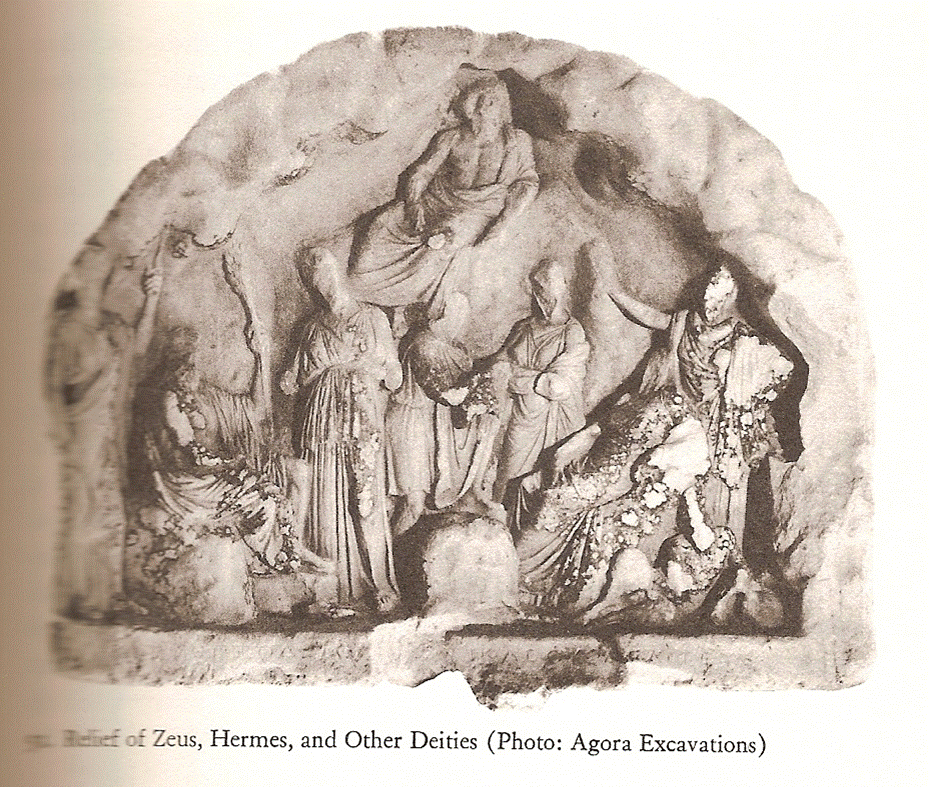
Ritual Activity
Cave of Pan and the Nymphs
Sacrifice-
Unknown
Dedications-
Various niches cut into the sides of the cave are believed to have held both the cult statue of Pan and dedications to him. The surviving dedications in relief form are the main reason we have been able to identify the cave, which is otherwise archaeologically bare. [10]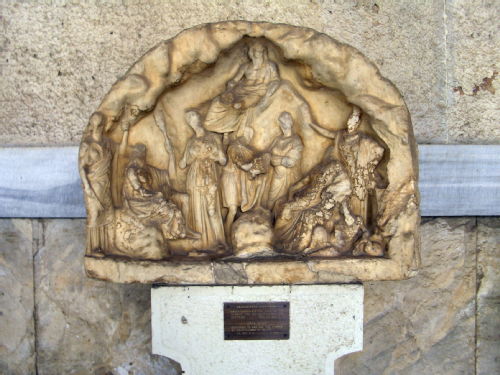
[image 11]
This votive relief was dedicated in ca.330BC by Neoptolemos, son of Antikles of
Melite. Melite was an Ionian Polis (on the modern Turkish coast) showing that the sanctuary was famous enough to attract visitors from great distance.
Festivals-
Herodotus details that an 'annual ceremony, with a torch race and sacrifices' took place to ensure Pan's continuing protection over the Polis. [12] It is believed that the torch race was in commemoration of Philippides' run to and from Sparta on the eve of the battle of Marathon. [13]
Cave of Apollo Hypo Makrais
Sacrifice-
Detail unknown, although Demosthenes tells us that this Apollo recieved honours as 'Apollo Patroos' in the city [14] and we have records of pigs being sacrificed to this form of Apollo.[15]
Dedications-
Similarly to the sanctuary of Pan we have a selection of niches for votive offerings in the cave. 10 plaques believed to have resided in these niches were found in 1897, all featuring a crown in relief and an inscription detailing that they are a dedication to Apollo on behalf of the 9 Archons. [16] However all can be dated to the Roman period, which leaves us with little idea as to dedications in the classical era. [17]
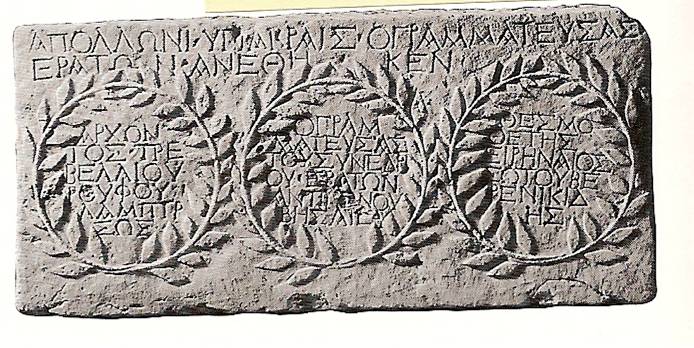 [image 18]
[image 18]
One of the ten devotary plaques from the Roman period found on the site of the shrine of Apollo Hypo Makrais. [19]
Festivals-
Again detail is unknown. We do know that one Phatry, the Therrikleidai had Apollo 'Patroos' as something of a patron deity judging from their boundary stones[20]. It is also suggested that Apollo was consulted prior to any building work, perhaps tying back into his Pythian aspect[21]. How this was achieved is unfortunately unknown.
Asklepieion
Sacrifice-
Unknown
Dedications-
We can see many, although certainly not all, the objects dedicated to Asklepius recorded in inventory lists which were publically displayed. These lists were kept throughout the life of the sanctuary, from 400BC to 250AD, and are believed to have shown roughly half of all the material dedicated on the site. They can be sub-divided into three aspects: Ex-votos (replications of healed body parts), coins and 'Typoi' (other specific dedications). It is also of note that the lists often show the identity of the dedicator, with 908 names listed, a far higher number than on the more famous lists for the Parthenon. This means we can analyse the clientele of the sanctuary pretty accurately.
The largest of group of dedications, by a distance, are the ex-votos. These are dedicated more frequently by women than men. These ex-votos could also be extremely valuable, most notably a pair of golden eyes dedicated by a man named Lysis in 339/8BC.
In terms of coin and typoi offerings however the dedicators were far more likely to be men. Two popular typoi offered were crowns and the ambigiously titled 'cult equipment'. It is also notable that, at least on the recorded dedications, local people frequented the sanctuary far more than foreigners. This may be because the lists, for display in Athens, wished to indulge those who would see them more often and thus curry favour but it does seem more likely that the sanctuary just had a local clientele.
If we take the inventory lists as a whole then we can see that women generally dedicated more (54.96% as compared to 42.55%, the remaining 2.49% is due to gender ambigious names). However this relationship is not a constant with dedication levels constantly fluctuating. The ratio of dedications from women as compared to men shifts from 4:1 all the way to 1:3 and back again throughout the sanctuary's history.
Alongside the annual inventories, from which the above information is taken, there are also several inventories made for specific purposes throughout the Askleipeion's history. For example one 3rd century BC list shows all the material in the sanctuary's storeroom and their state of repair, another from the end of the 2nd century AD lists all the objects which have been worn out and need to be replaced. [22]
A complete and in depth study of the dedications at the Askleipeion can be found in Sara Aleshire's "The Athenian Askleipeion: the people, their dedications and the inventories." However said book is both out of print and elusive within the university library system so may only worth pursuing if you wish to write about this in great depth.
Festivals-
Asklepius was seen to arrive into the city during the celebration of the Eleusian Mysteries, and his festival 'the Epidauria' always fell on a formerly empty day during the larger festival; the 18th Boedromion. [23] Unfortunately, as with much tied in to the Eleusian mysteries, we do not know what actually happened during the celebration.
Other-
The shrine itself was small, only 10.4m by 6m, presumably to fit into the space it had been allocated. Building on the slopes of the Acropolis cannot have been an easy endeavour.
The larger stoa, built at some point between 338BC and 326BC was larger, nearly 50m long and 10m deep and is notable for having an upper story. This makes it one of the first known stoas of this type. The increased size of the stoa as compared to the shrine does make sense however; Asklepieia were first and foremost places of healing and there needed to be space to accomodate patients.[32]
The sanctuary also features a small pit, built into a raised platform. This pit could have served sacrificial purposes, but it seems more likely to have housed sacred snakes; particularly when we take into account that Asklepius himself was supposed to have entered the city of Athens in the form of a sacred snake in 420/1 BC.[31]
Historical Significance
The entire area around the Acropolis was ringed by a path known as the Peripatos, which has subsequently been reconstructed by historians working from Pausanias. If you're interested you can find a video of the entirety of the Peripatos path, showing the sites of most of the shrines discussed above and a few which the Athenian's have made amusing claims about, here [28]
[28]
It is believed that all of the sanctuaries upon the slope of the Acropolis feel within the 'Pelasgian Ground'. This was ground, which we believe was later ringed by a wall, that was forbidden to build upon or quarry. It is of historical note that in the 430s BC, following the outbreak of the Peloponnesian war the attacks of Sparta upon the Attic countryside forced such overcrowding in Athens that this convention, suggested by the Pythia at Delphi, was ignored. There is a suggestion in Thucydides that this may have in some ways lead to the plague of the early 430s BC, which we can agree with on the grounds of modern medicine, if not the idea of angry gods.[29]
We have also found, embedded within a fragment of surviving wall an inscription reading 'boundary of the spring' close to the site of the Asklepieion. This has been dated as concurrent with an inscription in the Athenian Agora from shortly after the Peloponnesian war which reads: "The king archon is to set the boundaries of the sacred places in the Pelargikon and in the future no altar is to be established without the boule and the demos, nor is stone to be quarried from the Pelargikon, nor is earth or stone to be taken away..."
There is therefore a chance that the inscription we have found represents the limits of this sacred ground as set out by the king archon at this point. However this would only show us one, very small, glimpse of the larger wall which is likely lost to us.[30]
Who used the site, and where did they come from?
The only accurate analysis that can be made of the users of any of these sites, and where they came from, is for the city Asklepieion. Discussion of that is within the section on dedications for that sanctuary above.
Select Site Bibliography
Primary-
- Pausanias. Description of Greece
- Demosthenes. On the False Embassy
- Herodotus. The Histories
- Thucydides. History of the Peloponnesian War
Secondary-
- Camp J (2003) The Archaeology of Athens (New York: Yale University Press 2004)
- Parker R (1996) Athenian Religion A History (Oxford: Oxford University Press)
- Scott M (2008) Displaying lists of what is (not) on display, In Hayson M & Wallensten J (2008) Current Approaches to Religion in Ancient Greece (Stockholm: Stockholm Universitet 2011)
- Travlos J (1971) Pictorial Dictionary of Ancient Athens (New York: Hacker Art Books 1980)
- Wycherly R.E (1978) The Stones of Athens (Princeton: Princeton University Press)
Footnotes
1. Camp J (2003) 119-120, 254.
2. Herodotus. The Histories. 6.105.
3. Camp J (2003) 120, 254.
4. Travlos J (1971) 91.
5. Camp J (2003) 130, 254.
6 Demosthenes. 19.303.
7 http://www.britannica.com/EBchecked/topic/191201/Erechtheus
8. Travlos J (1971) 127.
9. Thucydides. History of the Peloponnesian War. 2.47.
10.Camp J (2003) 119.
11.http://www.davidgill.co.uk/attica/Pan_relief_2841.jpg
12.Herodotus. The Histories. 6.105.
13.Parker R (1996) 164.
14.Travlos J (1980) 91.
15.Parker R (1996) 313.
16.Travlos J (1971) 91.
17.Camp J (2003) 120.
18.Camp J (2003) 120.
19.Camp J (2003) 120.
20.Parker R (1996) 106.
21.Parker R (1996) 245.
22.Scott M (2008) 243-244.
23.Parker R (1996) 179.
24. Travlos J (1971) 70-71.
25. Travlos J (1971) 93.
26. Travlos J (1971) 129.
27.Wycherley R.E (1978) 179.
28.https://www.youtube.com/watch?v=VXBTgyIUjGo
29.Thucydides.History of the Peloponnesian War. 2.17.
30.Camp J (2003) 123-124.
31.Camp J (2003) 122.
32.Wycherly R.E (1978) 182.
Location
Located on the slopes surrounding the Acropolis in Athens.
Site Plan
Overview of the site, individual sites labelled by numbers. Click on image and open in a new tab to zoom in and locate. [24]
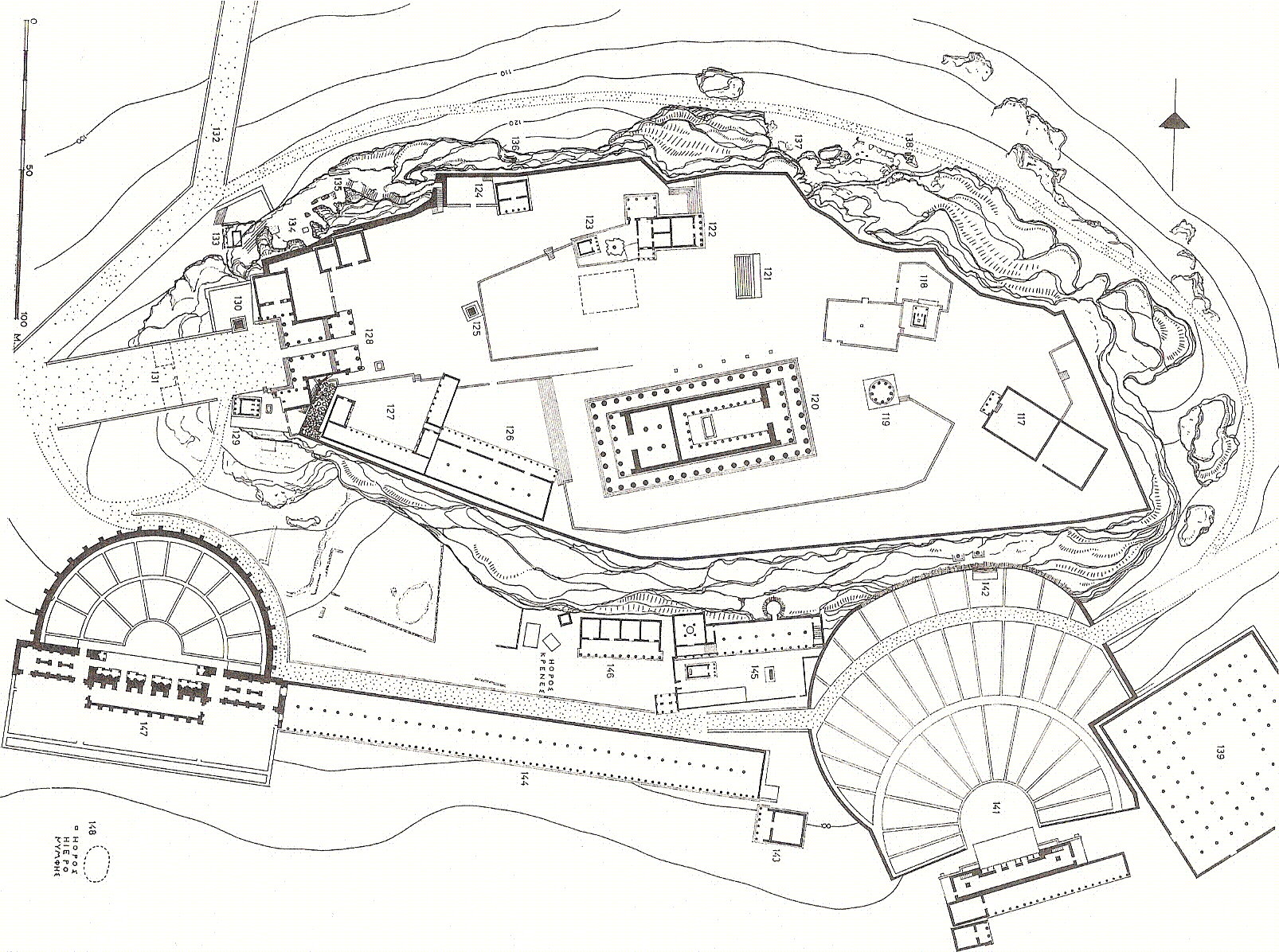
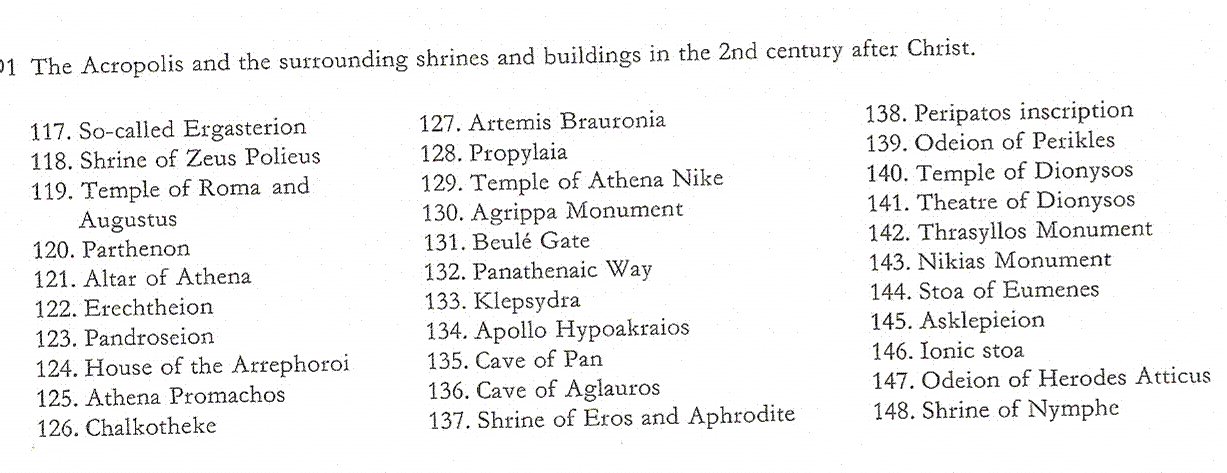
Closer view of the North (North west) slope [25]
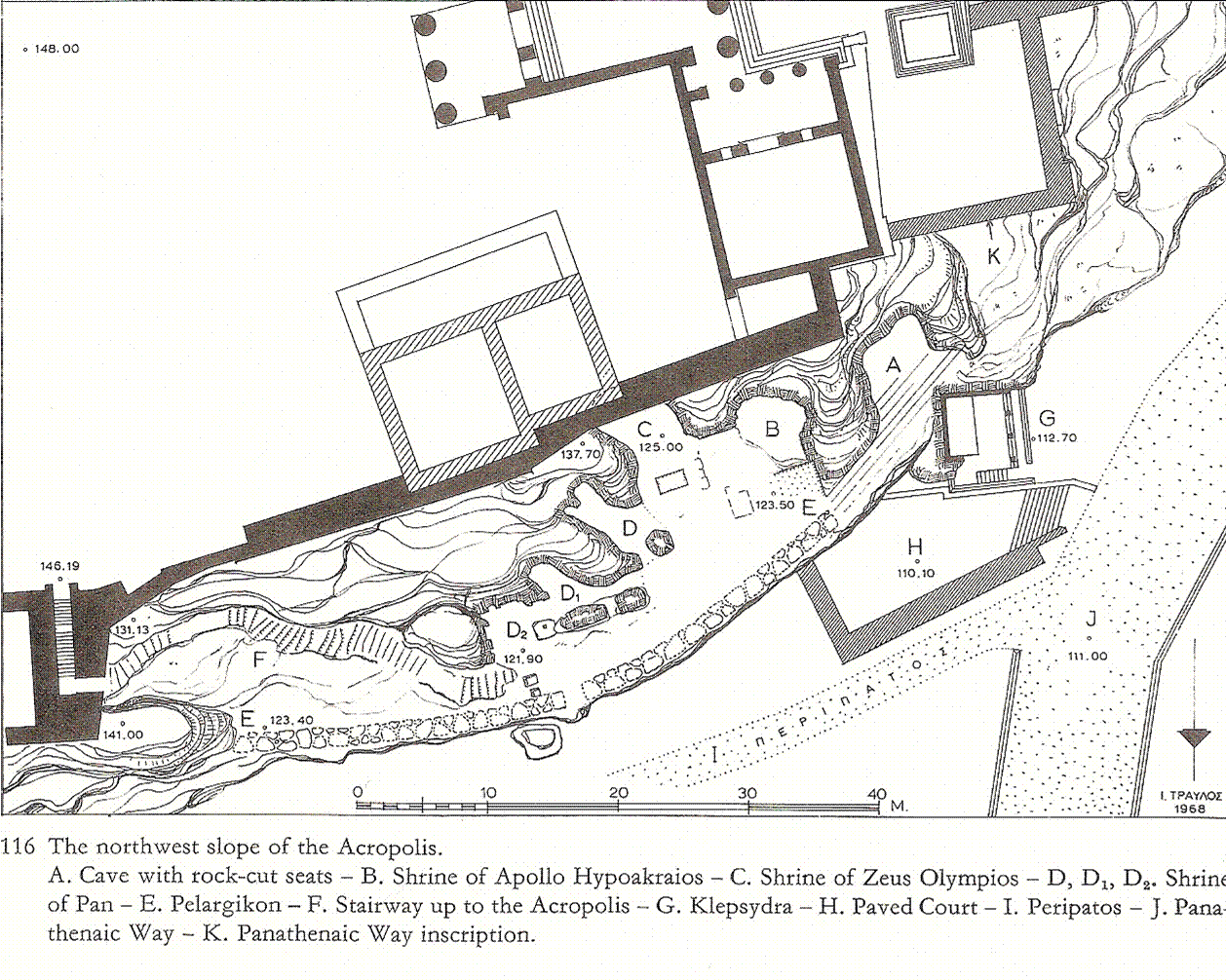
Plan of the Askleipeion [26]
